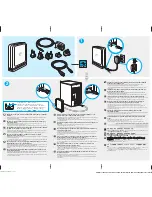
80
Brocade Network Advisor SMI Agent Developer’s Guide
53-1002701-01
FC routing
3
•
Brocade_PCSServiceCapabilities has a Boolean property called FCRCapable. If the property is
true, then the switch is FCR capable and is enabled. If false, the switch is capable and not
enabled. If null, the switch is not FCRcapable.
•
Each phantom switch is associated with Brocade_FCSwitchSettings and
Brocade_FCSwitchCapabilities. The FCSwitchSettings has the property called
PreferredDomainID, which is a settable property. A user can set the PreferredDomainID for the
phantom switches in the FCSwitchSettings instance. If the DomainIDConfigurable is true then
it would indicate that the DomainID settings can be modified. Modifying this property is a
fabric-disruptive operation due to intrinsically disabling of all EX_Ports connected to the
respective edge fabric, modifying the domain ID of the phantom switch, and then enabling all
the EX_Ports as required by the firmware. This applies to both the front and translate phantom
domains. In addition, by modifying the translate domain ID, and the need to disable or enable
the EX_Ports, the WWN of the translate domain is changed.
•
A port on FCR configured as an EX_Port is filtered out during port discovery on the backbone
for edge to edge device sharing.
•
An association called Brocade_SwitchFCPortOfPCSNetworkPort associates the front phantom
SwitchFCPort instance representing the FCR EX_Port in the edge fabric with the
PCSNetworkPort instance representing the FCR EX_Port on the FCR logical switch.
•
There is one instance of NodeFCPort for every entry in the name server. The SystemName
property reflects the Fabric WWN of the fabric where the port exists. In case of FCR setup,
where the devices are imported or exported, there may be multiple instances of NodeFCPort
where DeviceID is the same, but SystemName differentiates each instance based on fabric
membership.
•
The physical ports are represented as Brocade_PCSNetworkPort instances. In the backbone
view for every physical port, there is a CIM_NetworkPortCapabilities, identifying the
configuration capabilities of the port; and a CIM_NetworkPortSettings, identifying the
configuration details of that port. This class can be used to enable configuration of an FCR port
as an EX_Port by writing to the NetworkIDs property of the port's settings. Modifying this
property is a fabric-disruptive operation due to intrinsically disabling the EX_Port, modifying the
value, and then enabling the EX_Port as required by the firmware.
•
The property NetworkIDsConfigurable will indicate whether or not a port in the fabric is capable
of being configured.
•
From an SMI perspective, all fabrics which are physically connected are considered to be
contained in the same SAN.
•
If FCR setup where the backbone fabric and edge fabrics have been discovered -
Brocade_SAN.Name is the principal WWN of the backbone fabric.
•
If FCR setup where only one or more edge fabrics have been discovered - In the absence of the
backbone, there is no knowledge that the edge fabrics belong to one FCR backbone fabric, so
each edge fabric will be associated to its own SAN instance Brocade_SAN.Name which is the
principal WWN of that edge fabric.
Registration
Brocade_RegisteredProfile is mapped to Brocade_Switch using
Brocade_ElementConformsToProfile association class if edge switch is discovered along with its
backbone.
Figure 38
shows the SNIA Profile Registration model to advertise Inter-Fabric Routing profile.
Summary of Contents for Network Advisor SMI Agent 12.0.0
Page 4: ...iv Brocade Network Advisor SMI Agent Developer s Guide 53 1002701 01...
Page 8: ...viii Brocade Network Advisor SMI Agent Developer s Guide 53 1002701 01...
Page 118: ...104 Brocade Network Advisor SMI Agent Developer s Guide 53 1002701 01 Names 3...
Page 162: ...148 Brocade Network Advisor SMI Agent Developer s Guide 53 1002701 01 Life cycle indications 4...















































